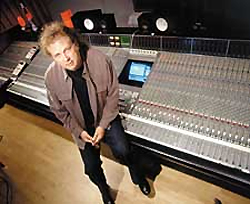
You’ve taken a lot of your time to share your techniques with everyone – I wanted to share a few of mine. I’ll get a lot of sequenced hi-hats, that just hit dead on the beat and it’s the same sample again and again – no change in texture, so I’ll use subtle flanging and panning to add some movement to them.
I like that – you can use the pencil tool to draw in subtle panning too. We used to do a similar thing back in the day using a Marshall Time Bucket Brigade delay. Anything that enhances the groove is great. Trying to put motion into something static.
For club music, sometimes I’m sending the entire mix minus the kick drum to it’s own bus – and putting bus compression on the whole mix minus the kick.
Another way to solve that is a dance technique, side chain the competitive elements to the kick, and compresses them more when the kick hits. I’ll put all the keyboards on an aux and sidechain from the kick. Especially with 4 on the floor Hip Hop.
Here’s a weird one. In good 808 sounds I hear what sounds like a “wind” sound coming off of the release. I think its the result of passing broadband noise through the 808 filters – it’s the ring the filters produce.
I make two duplicates of the 808, and put SPL De-Verb on one of the duplicates, and flip the other duplicate out of phase. This leaves the ring behind. Then I can EQ, compress or delay that wind tone and mix it back into the original sound.
With 808s and simple wave shape sounds, the first thing I teach my assistants is don’t reach for an EQ if it’s a simple wave form – just do it with loudness. Put it where you want and take out what you don’t like.
I do some phase manipulation tricks, but I’m hesitant to share them because they’re pretty advanced and can get you in a lot of trouble. Take the same signal, mult it and pan one hard left, one hard right, and feed that to an aux. Then flip one side out of phase – and then put a pan on it that pans so fast you can’t hear it.
A lot of times if I get a drum loop, I’ll isolate a sound that’s too loud and flip it out of phase and blend it back in. Any time I’m working with samples that are blended or layered, I’ll check the phase.
You’re famously quoted saying “It’s better to sound new than to sound good.” I remember being at AES with Tony Maserati playing a recent mix, and a bunch of engineers vibed him for the amount of compression on the lead vocals, but at the same time he had 200 tracks of audio working – it was a modern sounding mix and he needed to make the vocals present.
“It’s better to sound new, than to sound good. But the great ones do both.” is the actual statement. To beat a dead horse – Which would you rather have, the world’s greatest mix that sells three copies, or the world’s worst that sells five million. Audio engineers only make a small part of the audience. But if you can, why not try to do both?
Now, as for the compression – if I have 200 tracks, the first thing I reach for is not a compressor. It’s the mute button. It’s also rare that I’ll keep stereo basses as stereo.
I once did a mix that had 12 shaker parts, I muted 10 of them, the producer came in and said “Holy cow how did you get all those shakers to work? Now they’re all clear.” He hadn’t realized ten of them were muted!
Let’s say I’m an artist and I have the resources to hire any mixing engineer. Why should I hire Dave Pensado?
Any mixer that has had success will tell you that a big part of the process is having the arrogance (confidence) to think that your taste is always right. If you don’t have that, don’t join this profession. Once you feel what you do is right, it produces the answer of “because I’m the best.”
The proper forum is to ask other engineers why I’m good. I can’t give the answer without sounding conceited and arrogant. With artists, we as engineers have their career and well being in our hands, if you don’t have the confidence to assure them, they’re not going to work with you. Ultimately, your job is to make them a shit load of a money.
Matthew Weiss is the head engineer for Studio E, located in Philadelphia. Recent credits include Ronnie Spector, Uri Caine, Royce Da 5’9” and Philadelphia Slick.
Be sure to visit the Pro Audio Files for more great recording content. To comment or ask questions about this article go here.
